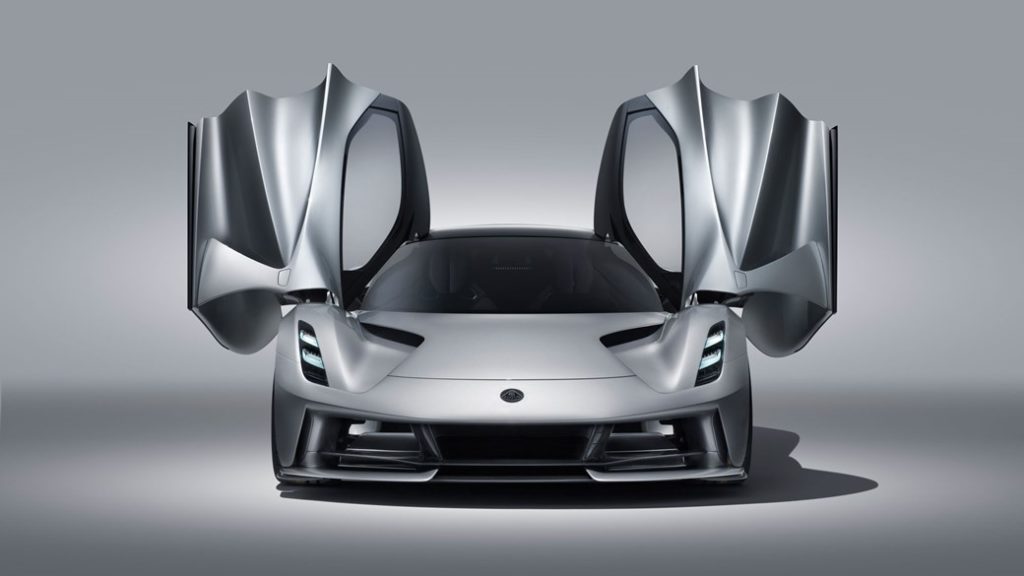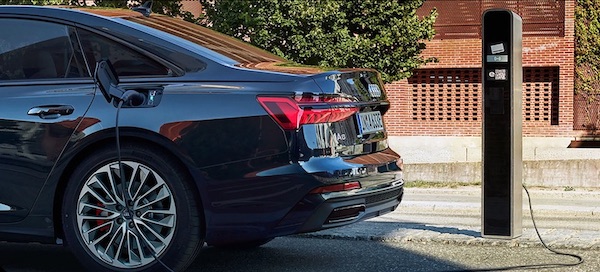Overview
Lotus Cars Limited, is a UK based automotive manufacturer, famed for its iconic sports cars and participation in Formula One. The automotive manufacturer has witnessed a number of changes to its ownership since the founding of Lotus Engineering Limited in 1952, by Colin Chapman and Colin Dare.
The company is currently owned by the Chinese automotive manufacturer, Geely, headquartered in Hangzhou, Zhejiang province. Geely also owns the automotive brands Volvo Cars and Polestar. Previously, Lotus was owned by General Motors. The company has the following electric vehicles (EVs):
- All-electric Lotus Evija
- All-electric Lotus Eletre Hyper-SUV
- All-electric Lotus Emeya Hyper-GT
Electric Cars: The Basics
For those of you new to zero-emission electric driving, we recommend a read of the following articles:
Sign up to the e-zoomed Electric Living newsletter
The All-Electric Lotus Evija Hypercar Coupé
The all-electric Lotus Evija hypercar is the most powerful production road car in the world. Hypercars is a term used to describe high-performance supercars. Hypercars are unusual and limited edition vehicles.
The pure electric two-door coupé Lotus Evija hypercar can deliver up to 2,000 ps of power and 1,700 Nm torque. The four-wheel drive EV can reach 0-62 mph in under 3 seconds, and 0-186 mph (300 kmh) in 9.1 seconds. The Lotus electric car has a top speed over 200 mph. The EV has five driving modes: Range, City, Tour, Sport and Track.
The EV has four independently controlled high-power density electric motors (500 ps power per electric motor). The e-motors were developed along with Williams Advanced Engineering (WAE).
No, you cannot have it delivered to your home right away. Though the automotive manufacturer had announced deliveries would commence in 2020, it has, since then, been delayed. Deliveries are now expected in 2023. The EV is expected to be manufactured at Hethel, UK, which has been the home for Lotus since 1966. Lotus will manufacture only 130 units, as a tribute to Lotus Type Number 130. The EV was revealed in July 2019.
Originally codenamed the Type 130, the name Evija (pronounced ‘E-vi-ya’) is derived from Hebrew, and means ‘the first in existence’ or ‘the living one’. The Lotus Evija is also the first pure electric British hypercar and also the world’s lightest production EV hypercar. The Evija uses a one-piece ultra-lightweight carbon fibre monocoque chassis (1,680 kg). It also utilises the concept of ‘porosity’ to reduce weight and increase performance.
The Lotus electric car has a 90 kWh EV battery mounted centrally behind the passenger compartment. Part of the EV battery is visible from the rear glass screen. The automotive manufacturer claims an electric range up to 215 miles (WLTP) on a fully charged battery. Of course, real-world electric range will be lower, impacted by a number of factors to include, driving profile and speed.
Lotus claims it has the developed the world’s fastest charging EV battery. The EV battery was also developed in collaboration with Williams Advanced Engineering (WAE). The EV is capable of DC charging up to 350 kW, enabling the EV battery to be charged from 10% to 80% in 12 minutes and to 100% in 18 minutes. Of course, the key is finding a DC charging station en-route, that can rapid charge up to 350 kW DC! The CCS2 charging port is located at the rear of the electric vehicle (EV).
Company-car drivers can take advantage of the lower Benefit-in-Kind (BiK-2%) tax charge for pure electric cars. You can lease electric cars e-zoomed at fantastic prices.
| PROS | CONS |
|---|---|
| Decent electric range | Expensive (priced to be confirmed) |
| Hyper performance pure electric coupé | – |
| 350 kW DC charging and 22 kW onboard charger as standard | – |
The All-Electric Lotus Evija Coupé (credit: Lotus)
| At A Glance | |
|---|---|
| EV Type: | Battery-Electric Vehicle (BEV) |
| Body Type: | Coupé |
| Plug-In Car Grant (PiCG): | Not Available |
| Engine: | Electric |
| Available In UK: | Available from 2023 |
| Variants (1 Option) |
|---|
| Lotus Evija (from £N/A) |
| EV Battery & Emissions | |
|---|---|
| EV Battery Type: | Lithium-ion |
| EV Battery Capacity: | Available in one battery size: 90 kWh |
| Charging: | 350 kW DC Rapid Charging (10%-80%: 12 mins). Onboard charger: 22kW AC (0%-100%: N/A hrs) |
| Charge Port: | Type 2 |
| EV Cable Type: | Type 2 |
| Tailpipe Emissions: | 0g (CO2/km) |
| EV Battery Warranty: | 8 years or 125,000 miles (70% or above) |
| Average Cost Of Residential Charging | |
|---|---|
| Battery net capacity : 16.7 kWh | £2.40 |
| Battery net capacity : 30.0 kWh | £4.32 |
| Battery net capacity : 39.2 kWh | £5.64 |
| Battery net capacity : 45.0 kWh | £6.48 |
| Battery net capacity : 50.0 kWh | £7.20 |
| Battery net capacity : 64.0 kWh | £9.22 |
| Battery net capacity : 71.0 kWh | £10.22 |
| Battery net capacity : 77.0 kWh | £11.09 |
| Battery net capacity : 90.0 kWh | £12.96 |
| Battery net capacity : 100.0 kWh | £14.40 |
- Note 1: The average cost of residential electricity in the UK varies depending on the region, supplier and type of energy used. An average for the UK is 14.40 p/kWh.
- Note 2: Not all EV manufactures make available the data on net EV battery capacity, and in a number of instances the EV battery capacity advertised, does not state if it is gross or net capacity. In general, usable EV battery capacity is between 85% to 95% of the gross available capacity.
| Charging Times (Overview) | |
|---|---|
| Slow charging AC (3 kW – 3.6 kW): | 6 – 12 hours (dependent on size of EV battery & SOC) |
| Fast charging AC (7 kW – 22 kW): | 3 – 8 hours (dependent on size of EV battery & SoC) |
| Rapid charging AC (43 kW): | 0-80%: 20 mins to 60 mins (dependent on size of EV battery & SoC) |
| Rapid charging DC (50 kW+): | 0-80%: 20 mins to 60 mins (dependent on size of EV battery & SoC) |
| Ultra rapid charging DC (150 kW+): | 0-80% : 20 mins to 40 mins (dependent on size of EV battery & SoC) |
| Tesla Supercharger (120 kW – 250 kW): | 0-80%: up to 25 mins (dependent on size of EV battery & SoC) |
- Note 1: SoC: state of charge
| Dimensions | |
|---|---|
| Height (mm): | 1122 |
| Width (mm): | 2000 |
| Length (mm): | 4459 |
| Wheelbase (mm): | N/A |
| Turning Circle (m): | N/A |
| Boot Space (L): | N/A |
| Lotus Evija | |
|---|---|
| EV Battery Capacity: | 90 kWh |
| Pure Electric Range (WLTP): | 215 miles |
| Electric Energy Consumption (kWh/ 100km): | 17.25 |
| Charging: | 350 kW DC Rapid Charging (10%-80%: 12 mins). Onboard charger: 22kW AC (0%-100%: N/A hrs) |
| Top Speed: | 200 mph |
| 0-62 mph: | Under 3 seconds |
| Drive: | All-wheel drive (AWD) |
| Electric Motor (kW): | 2,000 |
| Horsepower (ps): | 2,000 |
| Torque (Nm): | 1,704 |
| Transmission: | Automatic |
| Seats: | 2 |
| Doors: | 2 |
| Unladen Weight (kg): | 1,680 |
| Colours: | 7 |
| NCAP Safety Rating: | N/A |
While e-zoomed uses reasonable efforts to provide accurate and up-to-date information, some of the information provided is gathered from third parties and has not been independently verified by e-zoomed. While the information from the third party sources is believed to be reliable, no warranty, express or implied, is made by e-zoomed regarding the accuracy, adequacy, completeness, legality, reliability or usefulness of any information. This disclaimer applies to both isolated and aggregate uses of this information.










































